
The shape, the slithering movement, how they shed their skin, their designs and patterns, the danger and, of course, the size.
Few animals have spawned as many myths and legends.
Stories tell of 100 foot snakes that swallow men whole.
But how much of that is true. What are the top 10 biggest snakes in the world and how large do they actually get.
We’ll give you the top 10 list below and go into a little detail on each of the snakes. Then we’ll look at the largest snakes to ever live on earth, as well as the current record holding snake and a few potential challengers.
Finally, we’ll show you how you can measure your own snake to see how it stacks up. Let’s get started with the world’s largest snakes.
Table of Contents
Top 10 Biggest Snakes In The World
Big includes both size and weight The snakes highlighted here are both extraordinarily long and heavy. We’ll let you know which is the heaviest snake in the world and which is the longest snake in the world.
We kept the best for the last, meaning we’ll begin with number 10 and work our way to the biggest snake of them all.
10. Olive Python

The olive python is a native of Australia and identifiable by its unique coloring. The Olive python is scientifically known as the Liasis olivaceus. There are two subspecies of the olive python: the L.O Barroni and the L.O. Olivaceus.
The former is the larger of the two. It can grow to over 13 feet in length. The latter is usually between 6.5 feet to almost 10 feet long. The olive python is not venomous. Its daily diet consists of mammals, birds and other reptiles. A similar snake to this Australian python is the poisonous Mulga ( Pseudechis australis).
9. Black Mamba
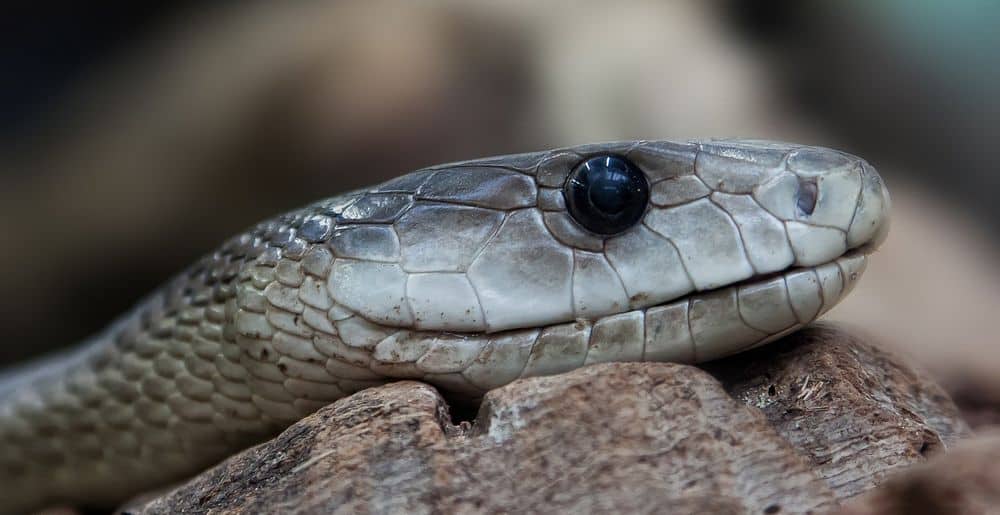
The black mamba is a large venomous snake from Africa. It is the second most venomous snake in the world. It can cause kill a human within 45 minutes of biting. The scientific name is Dendroaspis polylepis.
The Black Mamba can be as long as 13 feet. The longest black Mamba ever recorded measured 14.11 feet. This incredible snake is also the fastest snake in the world. It is aggressive by nature and will strike without provocation. So, next time you visit Africa, be on the lookout.
8. Boa Constrictor
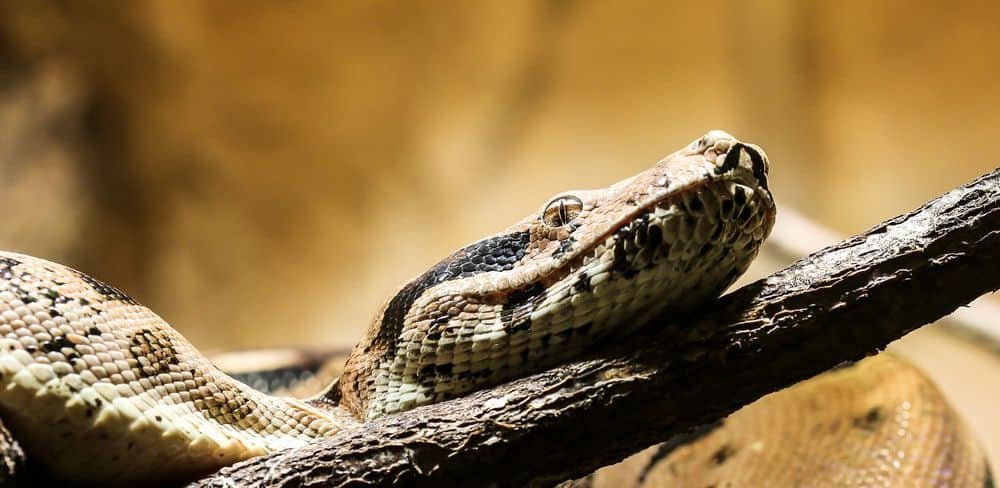
The Boa, like other constrictors, is not poisonous. It is a large snake with an intricate skin pattern and design. This colorful snake comes in tan, green, yellow, and red.
Boas are native to Central and South America. They can grow as long as 14 feet in the wild, but boa constrictors held in captivity rarely grow beyond 8.2 feet. Female boas are always longer than the males. You can keep them in the home as pets since they are not dangerous to human beings. The Boa constrictor can weigh up to 100 lbs.
Boa constrictors are great climbers and are usually found in trees. They also swim well. They prey on deer, monkeys, wild boars and birds and kill their prey by squeezing it to death.
7. Yellow Anaconda
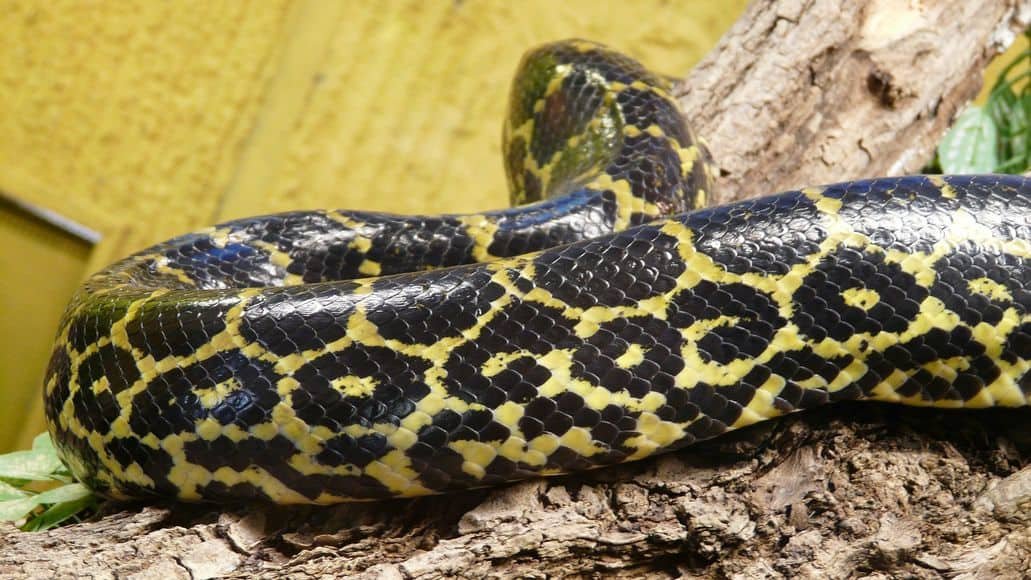
The yellow anaconda is the second largest anaconda in the world. You find it in the swamps, marshes, and rivers of South America. It is a member of the boa family and is non-venomous.
This anaconda has yellow skin with black spots, which its name was derived. Yellow anacondas weigh up to 132 pounds and can grow as long as 15 feet. They like to live alone and only seek companionship during mating time.
These snakes love to ambush their prey before killing them by constriction. Their skin gives them the perfect camouflage. Their diet consists of caimans, turtles, deer, peccaries, and fish.
6. Indian Rock Python And Burmese Python
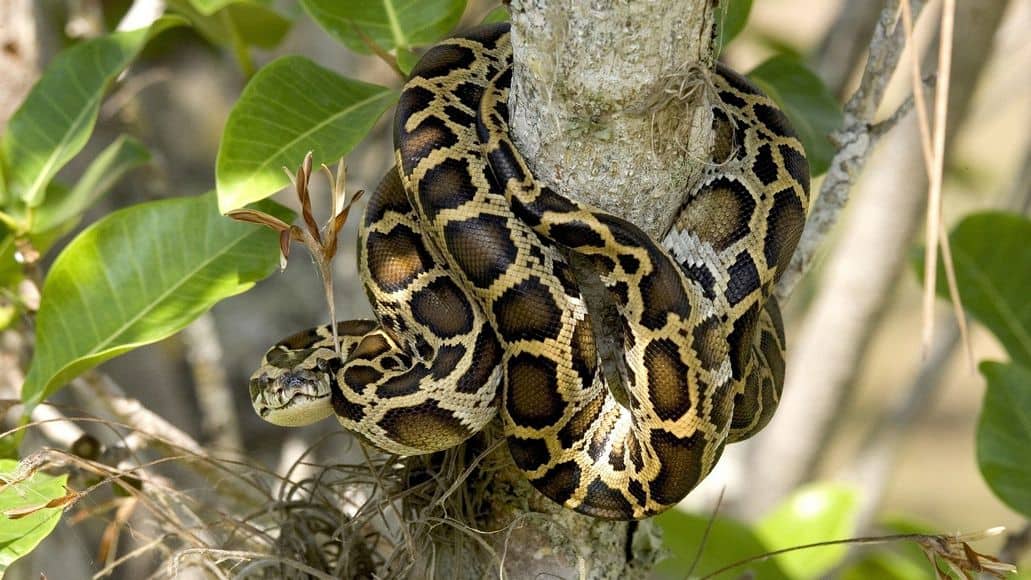
These are two species, but very closely related. Python molurus is the scientific name of the Indian rock python and the Burmese Python is called Python Bivattatus. You can guess from the names where these snakes originate, but they can be found all over south and southeast Asia, in Pakistan, India, Sri Lanka, Burma, China, Indonesia, Laos, Java, Borneo, Malaysia, and Nepal.
The Burmese python is slightly longer than the rock python. It is also darker in color. They can grow as long as 15 feet. The record shows a Burmese python that is as long as 18.7 feet.
The Burmese python is a favorite among snake breeders, especially the albino variety. It has amazing swimming abilities and loves hanging around water spots. If you intend to keep one, you’ll need to provide it a lot of water.
What do Burmese pythons eat? While they have been known to eat large mammals and reptiles, you can feed your rats or mice in captivity. And there is no record of one having eaten a human.
5. King Cobra

The King Cobra is called the king, because it is the longest venomous snake in the world. It has a non-aggressive personality when left alone, but can attack violently when confronted.
The scientific name is Ophiophagus Hannah and they are found in many Asian countries. They are easily the biggest poisonous snake found in the Philippines and many other Asian nations.
Male King Cobras are larger than females and can grow as long as 18.7 feet and weigh as much as 19.8 pounds. They continue to grow throughout their lives and can live as long as 30 years.
Cobras are born with fangs and venom, so there are no small cobras. This means a baby King Cobra can already attack and defend itself. Their venom can be fatal after 15 minutes.
4. African Rock Python
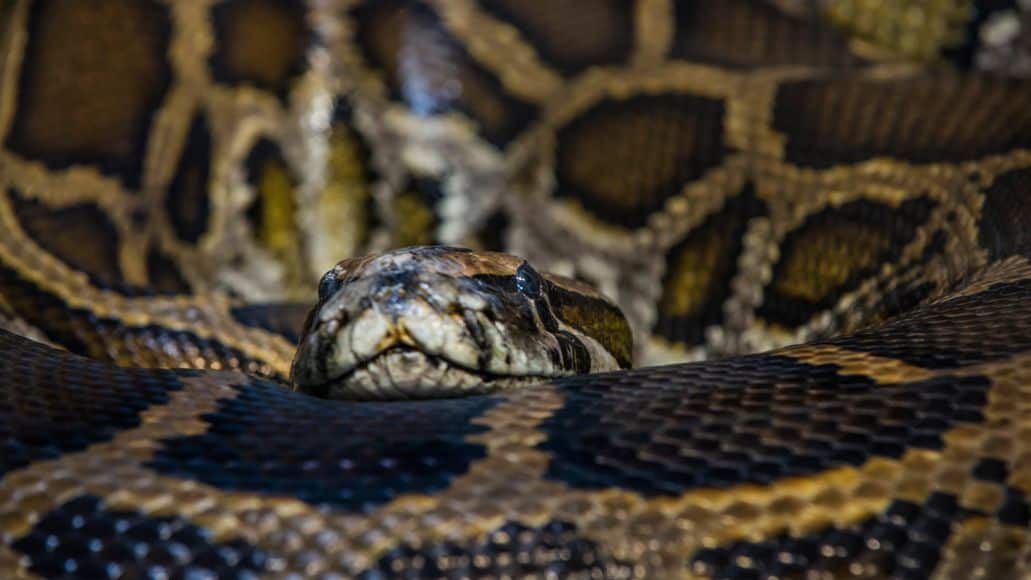
The African Rock Python lives in the tropical forests and temperate grasslands of Central and Western Africa. Reports claim an adult African rock python has been measured as long as 23 feet, but the largest generally grow to a maximum length of 20 feet. They can weigh up to 251 pounds, making them the biggest snake on the African continent.
This snake is characterized by their bold, dark blotches and markings. It is a solitary snake that only seeks companionship during mating season. It eats crocodiles, monitor lizards, pigs, antelopes, and monkeys. A big meal can sustain the python for up to a year. During the dry season, the African rock python goes dormant to conserve energy.
4. Green Anaconda

Eunectes Murinus is the scientific name for the Green Anaconda. It is the heaviest snake in the world and can weight up to 551 pounds and grow as long as 23 feet. Females are larger than males.
The Green Anaconda is an aquatic snake that lives in the tropical regions of South America. They are sometimes referred to as the water boa, because they spend most of their life in the water. They get their name from their olive green skin color with black patches.
Like their sisters, the yellow anaconda, green anacondas are predatory in nature and move with incredible speed in water. Their eyes and nostrils are on top of their heads, allowing them to hide their bodies beneath the water while they stalk prey.
Green Anacondas are nocturnal. While they can hunt during the day, they have heat sensing pits that make them ideal night hunters. They swallow their prey whole after suffocating it to death.
Despite what numerous Hollywood movies have taught us, these monstrous snakes do not prey on humans. They target crocodiles, caiman, tapir, fish, deer, and turtles. After mating, the female anacondas sometimes eat the males.
2. Amethystine Python
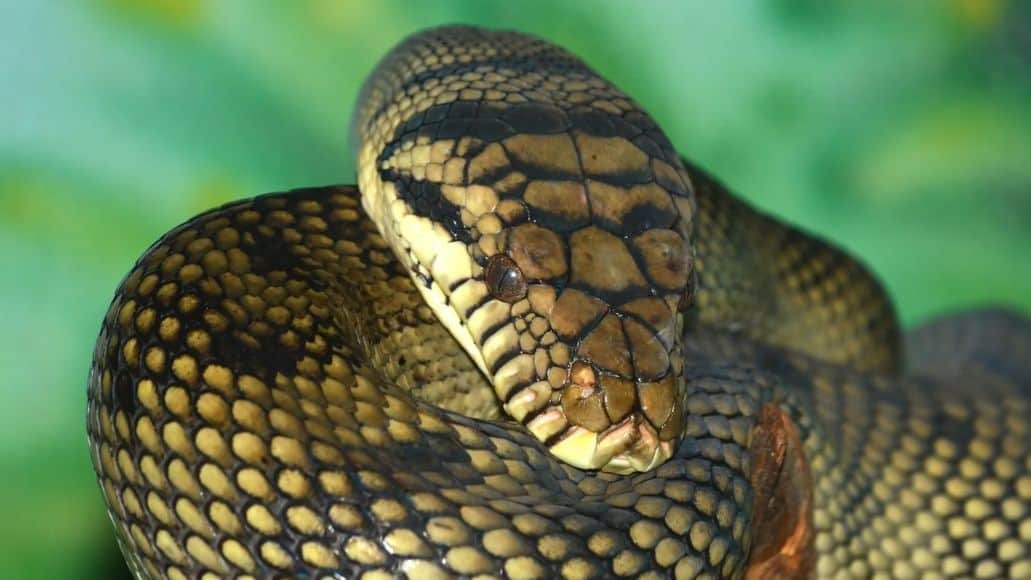
Another name for the Amethystine Python is the Scrub Python. It is the biggest nonvenomous snake in Australia. Its home is in the grasslands and rainforests of Australia, Indonesia, West Papua, and Papua New Guinea.
It can weigh up to 199 pounds and grow as long as 27.9 feet. The scrub python is scientifically known as Morelia amethystine. Males are smaller than females.
It is nocturnal like most pythons. It has heat-sensing pits along its jaws to help it hunt for prey at night. It constricts its prey. The Amethystine python feeds on birds, small mammals, rats, and bats, though it has the capacity to eat prey twice its size. It loves to rest in treetops or elevated places.
1. Reticulated Python
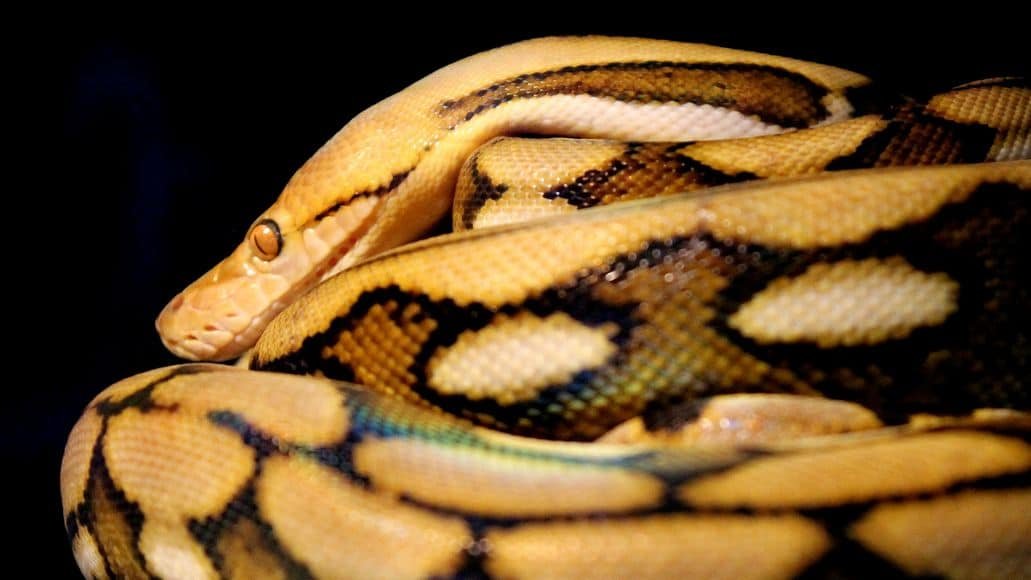
The Reticulated Python, or Python reticulatus, is the longest snake in the world. It can grow as along as 30 feet and weigh up to 297 pounds. It is usually found in the woodlands, rainforests, and rivers of Southeast Asia.
The Reticulated Python can be an aggressive snake when young, but is luckily non-venomous. It kills through asphyxiation.
It is nocturnal and can easily go undetected in its habitat because of its skin color and patterns. The colors range from gold, green, black and olive with brown blotches. This snake feeds on civet, rats, monkeys, deer, pigs.
Biggest Snake In History
Ages and centuries ago, big snakes existed and they still live among us. Records of their greatness and mystery are still in the pages of history. Detailed information may not be available but the little we know does a lot to stimulate the imagination. These are the largest snakes to have ever existed.
Titanboa Cerrejonensis
These famous snakes from history were gigantic. It is believed they lived about 60 million years ago. There is evidence of their existence from fossils found in the Cerrejon Formation.
The Titanboa could grow as long as 45 feet (12.8 meters) and weigh up to 2513 pounds (1140 kg). That is as long as a school bus or a T-rex and as heavy as a small car.
This pre-historic snake was discovered in a coal mine in La Guajira, Columbia. It lived in or near water during the Paleocene Epoch, the period following the end of the dinosaur era.
Gigantophis Garstini
The Gigantophis lived about 40 million years ago during the Late Eocene period. It had a length of about 33 feet. The name means “giant snake”. Charles William Andrews discovered this giant snake in Africa in 1901.
The facts state that the Gigantophis was a carnivore that may have preyed on Moeritherium. A Moeritherium was a mammal that existed in that period that looked like an elephant. Another Gigantophis fossil was discovered in Pakistan in 2014.
Madtsoia
The Madtsoia was a close relative to the Gigantophis. It was a scaly snake that was three times longer than a horse. It is believed to have weighed as much as two car tires. The Madtsoia was found in South America, Europe, Madagascar, and Africa. Like other prehistoric snakes, it lived from the late Cretaceous period through the Pleistocene Era.
Pythons
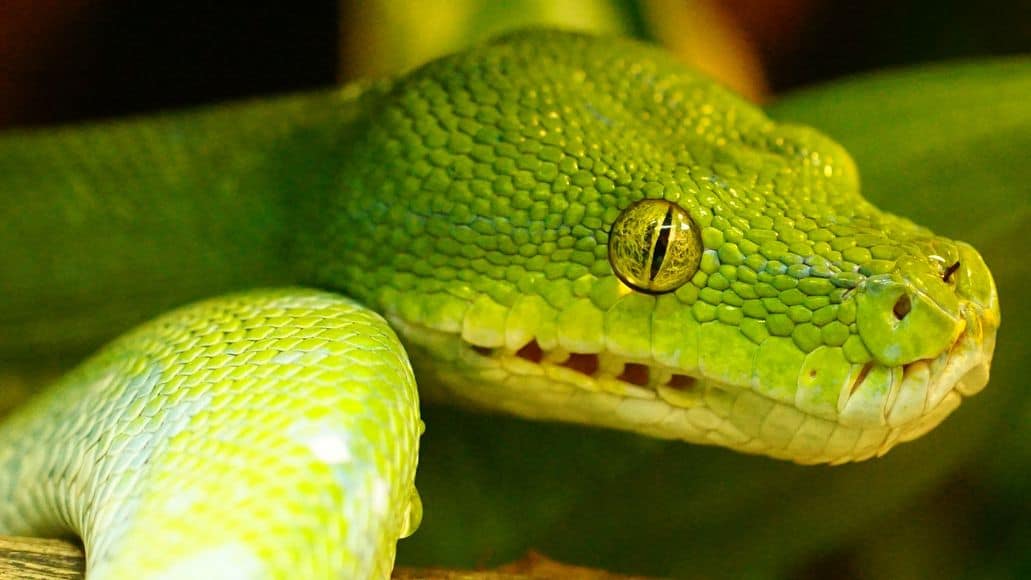
You can call Pythons, Pythonidae. These is the group of snakes with the most members listed as the largest and biggest snakes in the world. This group of snake consists of eight genera and 31 recognized species.
Pythons are non-venomous. They feed by constricting their prey until it experiences a cardiac arrest, then swallow it whole. They are ambush predators. Pythons can be motionless while in ambush and then spring into sudden action to attack their prey.
Because they swallow their prey whole, it takes weeks before full digestion occurs. They rarely attack humans, but are often hunted and captured by humans. Below are the Genera of Pythons
- Antaresia is the scientific genus for Children’s Pythons. It has four species
- Aspidities is the scientific genus of the Shield Pythons. This group has two species
- Bothrochilus is the scientific genus of the White-lipped Pythons, having seven species
- Liasis is the scientific genus of the Water Pythons. It has five species
- Morelia is the scientific genus of the Tree Pythons, with seven species
- Python is the scientific genus of the True Pythons, with another seven species
Pythons lay eggs and incubate them before they are hatched into baby pythons. Pythons are bulky and big for their age. They move in a rectilinear progression. In simple terms, they move by scooting forward in a straight line. They move at a speed of 1 mile per hour. Pythons can live up to 35 years. The normal life expectancy is twenty-five years.
Anacondas
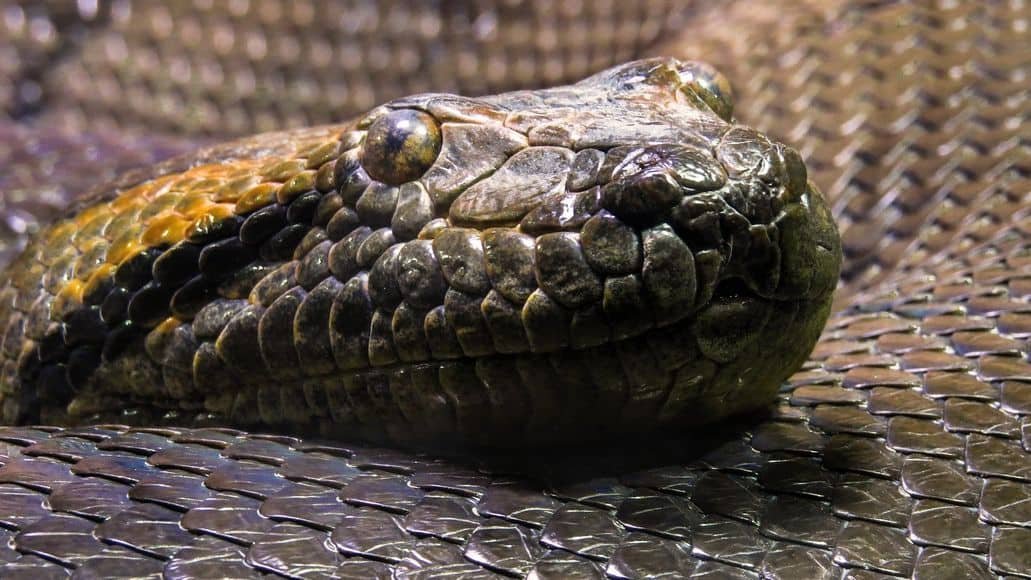
These are a group of aquatic snakes of the genus Eunectes. The word Eunectes means good swimmer. There are four recognized species of anacondas.
Anacondas are known to constrict and crush their prey. They are the heaviest known snakes in the world, found in the tropical regions of South America. There is a myth of giant Anacondas that can reach lengths of 100 feet,but this has never been scientifically proven.
Anacondas are muscular and thicker than any other boas. They tend to have large heads with a thick black stripe that runs from their jaw to the eyes. Eyes and nostrils are on the head, so they can breathe and see, while mostly submerged.
Female anacondas are larger than males. Anacondas love the murky waters of swamps and slow-moving rivers. They are found in the rainforest where they love the heat and humidity. The four species of anacondas are
- Green anacondas
- Yellow anacondas
- Bolivian anacondas
- Dark-spotted anacondas
Anacondas constrict their prey and overwhelm the circulatory system. This hinders blood from getting to the brain. Most of their prey, however, die from drowning.
Anaconda mating involves two to twelve male anacondas for one female. The males fight to mate but the choice is up to the female. Female anacondas gestate for seven months and do not eat anything during the period. Anacondas give live births. The baby anacondas immediately have to fend for themselves. In captivity, Anacondas can live up to 30 years and 10 years in the wild.
Present Day Biggest Snakes
Below are three contenders for the world’s biggest snake. These are live examples of giant snakes that were caught or held captive. Some are confirmed and others have only a photo or reports to back their existence. Regardless, these snakes’ humongous sizes are worth mentioning in this article.
Medusa Snake
The Medusa is the longest snake currently alive in the world and also holds the world record. It is still in captivity. It is a Reticulated Python that weighs 353 pounds and is 25 feet 2 inches (7.67 meters) in length. It is 18 years old (in 2020), so it could still grow even longer and bigger. The Medusa’s owner is Fox productions in Missouri. You can find Medusa “The Edge of Hell Haunted House” in Kansas City.
New World’s Largest Snake?
The capture of a 48 foot, 8 inch reticulated python in Indonesia by villagers in 2003 got some media. The news from the local newspaper claimed that the python weighed 983 lbs.
The snake lived at a primitive zoo on the main island of Java. Its diet consisted of eating three to four dogs monthly. The confirmation of the existence of the reticulated Python by the Guinness Book of records was pending at last report. If true, this would be the World’s biggest snake both in length and size, but since it has been so long without an update, we have to assume it turned out to be false.
Malaysian Python
Another reticulated python’s capture at a construction site in 2016 is worth mentioning. The Python made its home in an uncompleted flyover in Paya Terubong, Penang, Malaysia. An official known as Herme Herisyam, who works with the Malayan government, caught the snake.
The Python was exactly 8 meters long and weighed 250 kg. Photos show members of the Malaysia Civil Defense Force carrying the giant snake. Unfortunately, the python died three days after it was taken into captivity.
This Malaysian Python was the longest Reticulated Python in the world for three days before it expired. It died while laying an egg, but rough manhandling or injury could have caused it to die.
How To Measure your Snake
Now, we know all the big snakes and their weight and length. You might be wondering how to measure your snake. Perhaps you have the next record holder as the world’s biggest snake. Here are 3 ways to measure a snake.
Method 1
Use a string to follow the contours of your snake’s body from the head to tail. Take the string and put it against a ruler to determine the length of your reptile in feet or meters.
You should take three different measurements at different times. This is to allow for your snake’s movements and turns. You then take an average of the three measurements to determine the true length of the snake.
Method 2
You can simply use a ribbon measuring tape. Place it on your snake the get the exact measurement and length.
Method 3
There are computer programs designed to help measure your snake easily. An example is the Serpentine Widgets Snake Measurer. It was designed in 2001 and gives an accurate measurement of your snake’s length.
It works using an uploaded picture of your snake from above. The picture must be taken when your snake is on a flat surface. You need to input a ruler length of your choice after clicking two points.
You then begin picking points on the snake’s length after the snake button is activated. You must start at one end until you get to the other end. Once you are done, the program gives you your snake’s length in the desired units you chose.
Preferred Method
All 3 methods are fine. You determine which one works best for you and your snake. The third method may be too techy for some people. Others may like the simplicity and magic of technology. Using methods 1 or 2, you may require the help of one or two people, if you are measuring a big snake.
World’s Biggest Snakes: Final Thoughts
You might be thinking how great it would be to own one of the heaviest or longest snakes on earth. But the bigger the snake, the bigger the demands and responsibilities
Big snakes eat more food, needs a larger space and more care. If you are committed to giving your snake all your best, then go ahead. If this is your first snake, though, we strongly recommend you start with a smaller snake more suited to beginners. After you gain some experience, you will be better able to care for the big ones.
Leave a Reply